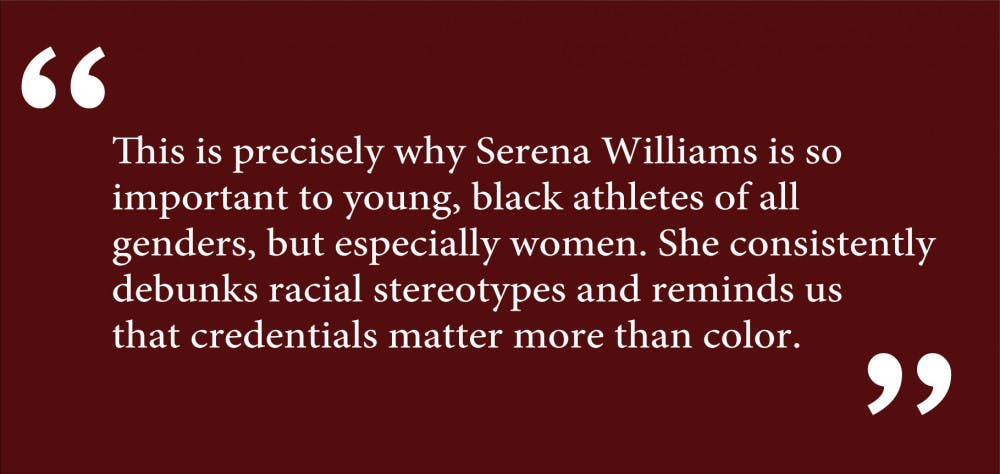This year has been a big one for women’s tennis. Serena Williams, arguably the greatest living tennis player, won a Grand Slam while pregnant and delivered a beautiful baby girl. Meanwhile, her rival Maria Sharapova not only returned to the circuit after fulfilling the conditions of her suspension for using banned substances, but also authored a book. That book immediately threw Sharapova back under the spotlight for her ill-advised — and racialized — comments about Williams. They echoed the ubiquitous misrepresentation of black women that is all too common in the athletic community and society as a whole, and offer a telling reminder of why we need to challenge these stereotypes.
By Sharapova’s account, she was 12 years old when she first saw the Williams sisters play in an open practice session in Florida. Despite the raging crowd, Sharapova decided not to sit in the stands. “I’d never put myself in the position of worshiping them, looking up, being a fan,” Sharapova recounts. Ultimately, her father found a nearby shed for her to watch the match without being seen. “I could watch through a kind of knothole — just me alone, in the dark, seeing the next 20 years of my life,” she recounts. But the truly problematic part of the book came later: when Sharapova refers to Williams’ presence on the court. “First of all, her physical presence is much stronger and bigger than you realize watching TV,” Sharapova writes. “She has thick arms and thick legs and is so intimidating and strong. And tall, really tall.”
For starters, this statement blatantly ignores the fact that, in reality, Sharapova is the taller player. She towers over Williams by five inches and is a powerful tennis player in her own right. But the statement is particularly troubling in light of the physical build and color of both athletes. The image of a “little girl” playing against a “grown woman,” as Sharapova describes their first match, brings to mind the stereotype that black women are somehow threatening, even when they are just navigating the spaces that belong to them. Instead of objectively crediting Williams for her superior skill and accomplishments, somehow Sharapova is able to idealize her own wins and make excuses for her defeats — excuses that are rooted in racialized misperceptions. It’s unfortunate that no matter how hard Williams competes, no matter how many Grand Slam titles she earns, she is constantly undervalued and critiqued for her body.
Here lies the difference between white excellence and black excellence: White excellence doesn’t have to battle the omnipresence of racism to gain recognition. Williams can beat Sharapova all she wants (her record stands at 19-2) but the narrative seems to stay in Sharapova’s favor. She initially received more endorsements, even though her claim to fame is regularly losing to Williams. She gets to play on center court, although she is often ranked lower than other players assigned to smaller courts. Bizarrely, she still received this center court preference in the U.S. Open last month, though she was just emerging from a doping scandal at the time. She regularly gets the benefit of the doubt — chalking defeats up to injuries or fatigue — instead of being expected to win in spite of everything like Williams.
The advantages Sharapova receives — both on and off the court — as the losing member of the Williams-Sharapova rivalry is rooted in what has been historically celebrated in this country. For far too long, global standards — about athletics, beauty, marketability — have been shaped by images of white women’s bodies. In commercials, movies and magazines, there is an overrepresentation of easy-to-sell, blond-haired, green-eyed, slender white women. This imbalance tells the next generation of black women that their bodies will consistently be perceived as lacking. And it tells black female athletes that their accomplishments will always be undermined solely because of their identities. This is precisely why Serena Williams is so important to young black athletes of all genders, but especially women. She consistently debunks racial stereotypes and reminds us that credentials matter more than color.
In the context of these trends, Sharapova’s book isn’t just a petty attack against a tennis rival — it’s much more. Her book had many stereotypes that underrate black excellence, demean black women’s bodies and create artificial hurdles for women of color. The widespread criticism of Sharapova for her tone-deaf comments has been encouraging, but many Americans still share the same views. Clearly, we still have a long way to go when confronting biases and stereotypes specifically targeted at excellent, black women. But the overwhelming support for Williams is a start.
Randi Richardson ’20 can be reached at randi_richardson@brown.edu.



